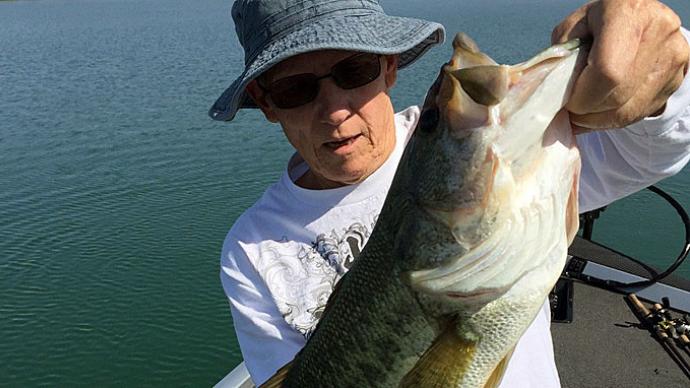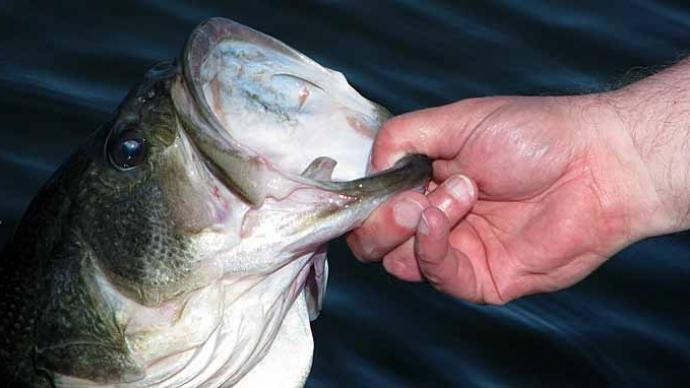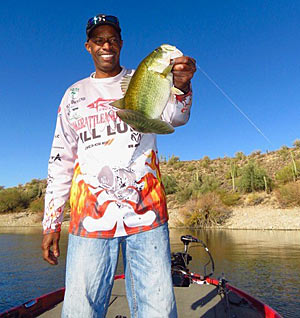
Marc Townsend has been called “old school,” but he takes that as a compliment. While the competition is dabbling tiny baits on light line, Townsend is most likely throwing a big Carolina rig and smacking toads with it. A Carolina rig may be old school, but it’s an excellent way to search for and catch bass, shallow or deep.
The Rig
A Carolina rig is stout line on a stout rod with a leader following a heavy weight. Townsend uses 50-60# braid on his main line and 12-pound-test fluorocarbon or mono for the leader. Which one he uses depends on whether he wants the lure to float up. Using a long mono leader will help the bait float. This is particularly helpful on very soft bottoms or when there is grass on the bottom. For harder bottoms, he uses fluorocarbon line, and he generally prefers a 4-foot leader. Your rod should be long with a lot of backbone but a slightly limber tip to make it sling that long rig easier. Most rod manufacturers will have a Carolina Rig rod, so play with a few until you find one that feels good to you. Top that rod off with a robust and fast reel with a lot of line.
Marc has done a LOT of pool fishing – testing various rigs in his swimming pool to see how they perform. As a result, he rarely uses any weight smaller than a ¾- or 1-ounce egg sinker. To tie up a Carolina rig, slip your egg sinker onto the braid, then tie on a good-quality swivel. The swivel helps to reduce line twists. Invest in the best swivels and hooks you can find – the swivel is going to take a lot of pressure, and you’re going to be setting that hook with a lot of line out. Make sure it’s light but strong and very sharp. Touch up the tip now and then, and make sure you also check your line and your knots frequently. It’s a pain to retie, but losing a big fish is a lot more painful.
The Lures
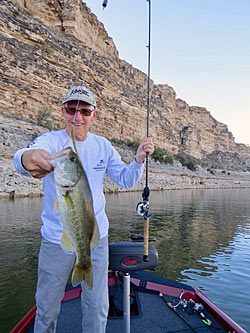
A lizard is a classic Carolina rig bait, but it’s not the only bait you can use. Your choices are almost limitless. Townsend likes Brush Hogs and lizards, and you can also use worms and craws. One bait not a lot of people think about using is a big tube. They have an excellent bulky profile, but since they are hollow, they float up well. You can stick a piece of Styrofoam peanut inside, and they’ll float up even better. When you pull on the rig, the tube will dart down and forward, then float back up when you stop. Put a bit of dye on the tentacles to make the waving more noticeable. A super floater worm is also great, but make sure you test them in the water to ensure the hook you’re using doesn’t overpower the buoyancy of your lure.
Inactive, suspended fish can often be tempted by these floating baits that stay at their level. In addition to the tubes and super floaters, you can use a floating lure like one of the super plastics. You can add a Carolina Floater from Betts Tackle to your regular plastic to make it float. (The Carolina Floater looks like a sinker, but it floats the lure up instead of weighing it down. Peg it next to the hook). Senkos can also be a killer on sluggish fish.
Fishing The C-Rig
The key to fishing this rig is to remember where the lure is. When you feel the sinker hitting a tree or a rock, you must remember that the actual lure may be four to six feet behind it, depending on your leader's length. Never jerk the sinker out of a tree or a hang-up--pull it loose slowly, and let it fall. That way, the lure will follow along behind and stay on the cover where the fish are.
The great thing about a C-rig is that you can quickly cover water but still keep a subtle presentation. Long points, flats, channels, and even submerged islands and trees are great places to fish the C-rig, and it’s a dynamite choice for fishing grass. When fishing grass, a weight with more of a point to it will slip through the grass more efficiently than an egg sinker. Townsend first approaches a point from the side and pulls his bait over it at 90 degrees, shallow to deep. He slowly moves around toward the tip of the point, casting and retrieving, so he covers the entire point.
The best way to move the rig is to pull it by moving your rod to the side. You don’t want to just let the boat pull around because that’s the perfect way to snag constantly. Sling that rig out let it free spool until the line goes slack, and you know the sinker is on the bottom. Take up any slack, and once you can feel the sinker, start moving it by pulling your rod to the side. You’ll be able to feel it move along the bottom, hit and climb over rocks, and even crawl up tree stumps. When it crawls up something, push the rod forward to give it slack as it falls down the other side so the lure stays close to the structure instead of yo-yoing away from it.
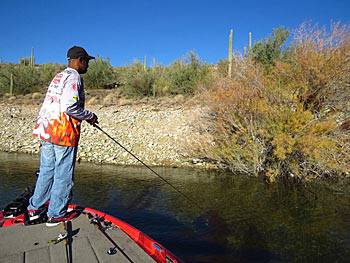
The bite might be a definite thump, or it may just feel like you’ve hooked a rubber band. While pulling the weight with the rod, the lure is pulled down and forward through the water. It gets closer to the bottom as it goes, but when you pause and wind up the slack, it allows the lure to pause, then drifts upwards until you start to drag the rig again. A fish will often grab it just as it pauses, and when you start to drag the rig again, you will feel the extra weight. Set the hook when the rig feels heavy, and don’t give the fish any slack when you’re hauling it in. This is where the fast reel comes in handy.
Other Details
The slower the bite, the longer the leader. A shorter leader can make it easier for the fish to find the bait in very dirty water. Townsend often adds a rattle to his C-rig baits, especially lizards. Townsend also uses a permanent marker to black out the last few feet of line in front of the lure, and he sprays his lures with scent just about every other cast. On long banks, he fishes the rig at a 45-degree angle. He says the fish seem to like it best that way.
A Carolina rig is one of those classic presentations that seem to work in any season, at any depth, on any body of water. Make sure to keep one tied on!


